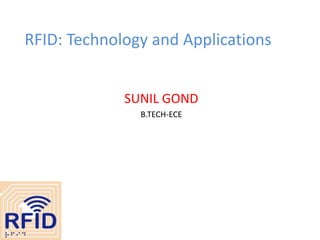RFID
- 1. RFID: Technology and Applications SUNIL GOND B.TECH-ECE
- 2. Outline ï§ RFID History ï§ What is RFID? -RFID System Components ï§ RFID Tag -Type of Tag -Tag block diagram ï§ RFID Reader ï§ Future ï§ RFID advantage ï§ RFID disadvantage ï§ Applications ï§ Conclusion RFID-2013 GALGOTIAâS COLLAGE OF ENG. AND TECH. G. NOIDA
- 3. RFID History âĒ First Bar code patents â 1930s âĒ First use of RFID device â 2nd world war â Brittan used RFID-like technology for IdentifyFriend. âĒ First RFID Patent - 1973 âĒ Auto-ID center founded at MIT â 1999 âĒ Current thrust primarily driven by Wal-Mart. GALGOTIAâS COLLAGE OF ENG. AND TECH. G. NOIDA
- 4. What is RFID? âĒ RFID = Radio Frequency IDentification. âĒ An ADC (Automated Data Collection) technology that: â uses radio-frequency waves to transfer data between a reader and a movable item to identify, categorize, track. â does not require physical sight between reader and the tagged item. â Performs the operation using low cost components. Other ADC technologies: Bar codes, OCR. GALGOTIAâS COLLAGE OF ENG. AND TECH. G. NOIDA
- 5. RFID : CIRCUIT DIAGROM
- 6. RFID tags âĒAn RFID tag is a microchip combined with an antenna in a compact package. âĒRFID tags can be very small. âĒTags can be attached to almost anything: â Items, cases of products, high value goods â vehicles, assets, livestock or personnel
- 7. Types of Tags âĒPassive Tags â Do not require power â Draws from Interrogator Field â Lower storage capacities (few bits to 1 KB) â Usually Write-Once-Read-Many/Read-Only tags â Cost around 25 cents to few dollars âĒActive Tags â Battery powered â Higher storage capacities (512 KB) â Typically can be re-written by RF Interrogators â Cost around 50 to 250 dollars
- 8. RFID readers âĒ Reader functions: â â â â â Remotely power tags Establish a bidirectional data link Inventory tags, filter results Communicate with networked server(s) Can read 100-300 tags per second âĒ Readers (interrogators) can be at a fixed point such as â Entrance/exit â Point of sale
- 9. RFID Antennas: âĒ Gate antennas âĒ âĒ Patch antennas âĒ Circular polarized âĒ Di-pole antennas âĒ Linear polarized
- 10. The future: RFID: Driving intelligence to edge of Enterprise networks Analog sensors replaced with cheap digital sensors: Motes, etc Enterprise Management Systems adapted to more effectively react in real-time to data. Our professional lives Precision Automation Our personal lives
- 11. RFID advantages âĒ Multiple items can be read with a single scan âĒ Each tag can carry a lot of data (read/write) âĒ Individual items identified and not just the category âĒ Passive tags have a virtually unlimited lifetime âĒ Active tags can be read from great distances GALGOTIAâS COLLAGE OF ENG. AND TECH. G. NOIDA
- 12. RFID disadvantage ï§ Lack of industry and application standards ï§ High cost per unit and high RFID system integration costs ï§ Weak market understanding of the benefits of RFID technology
- 13. RFID applications ï§ Access control for people; -Secure access to work place -Access to travel on train ï§ Access control for vehicle; -Secure access on site -Istant payment of fuel. âĒ Security â Access control â Counterfeiting and Theft control/prevention âĒ Location Tracking â Traffic movement control and parking management â Wildlife/Livestock monitoring and tracking
- 14. CONCLUSION âĒ RFID benefits are due to automation and optimization. âĒ RFID is not a plug & play technology. âĒ Awarneness of RFID technology. âĒ Technology is evolving but physics has limitations.
- 15. THANK YOU















